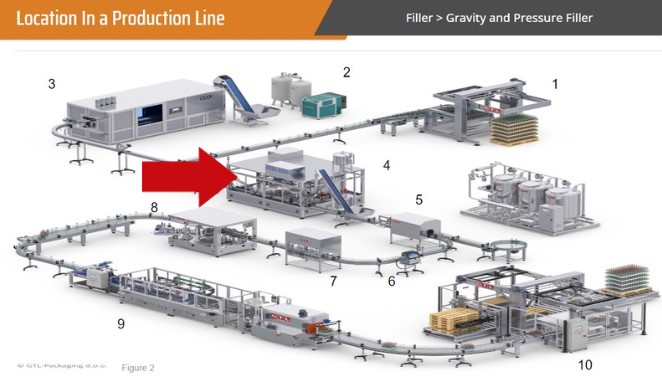A Complete Overview into Gravity and Pressure Fillers
Choosing the Right Filling System for Your Production Line
Gravity and pressure fillers have gained popularity in the manufacturing industry due to their versatility and customizable features. These machines are designed to fill containers by releasing valves connected to a tank, allowing the product to use gravity to flow into your container. Depending on your product’s viscosity, these fillers can be a great addition to your operation - leading to increased fill rates.
In this guide, we’ll go over the following:
- What are gravity and pressure fillers?
- Gravity vs. Pressure Fillers
- When to recommend piston filling?
- Inline vs. Monoblock Machines
- Where to find in a production line?
- Favored Manufacturers
- Industries Used In
- Summary
What are gravity and pressure fillers?
These machines fill containers by releasing valves, which are connected to a storage tank. This causes your product to flow into and fill containers. Gravity fillers operate by letting gravity do the work to fill containers. They are more suited for low-viscosity liquids, such as water, milk and fruit juice. On the other hand, pressure fillers utilize positive displacement pumps, allowing them to move a wider range of more viscous liquids, such as creams, gels or lotions.
Gravity vs. Pressure Fillers
Gravity Fillers
A typical gravity filler, without a pressurized system, is the most economical option when it comes to filling containers. However, without a pressurized system, you will be limited to filling only thinner liquids.
[Source: Apex Filling Systems]
Pressure Fillers
By adding a positive displacement pump and converting it to a pressure filler, you will experience a rise in cost, but you’ll be able to use the machine for a wider range of thicker liquids. This type of filler is beneficial for products that are challenging to extract from the holding tank, as well as getting them to come out of the nozzles and into your product container.
When to recommend piston filling
If you're considering a gravity or pressure filler, it’s important to send in a sample of your product to ensure the machine will work with it. If your product has a high viscosity that makes it difficult to come out of the nozzle, you may need to upgrade to piston filling. Piston filling is the next step up for dealing with highly viscous liquids.
Inline vs. Monoblock
These units are either inline or monoblock and both have their pros and cons.
Inline machines
Inline fillers fill containers in a line as they are conveyed into the machine. Although they are cost-effective, they require a larger footprint because a separate capping machine needs to be added down the line. On the other hand, monoblock machines are all-in-one units.
[Source: Maharshi Udyog]
Monoblock machines
For those who prioritize maximum speed and efficiency and want to minimize their footprint, the monoblock system would be the ideal choice. However, it should be noted that these units are more expensive and have the potential for longer downtimes and greater replacement costs compared to inline units.
[Source: FILL TECHNIC MACHINERY]
Where to find in a production line?
[Source: GTL Packaging]
Additional Equipment
If you are considering purchasing a gravity or pressure filler, you may also require certain upstream and downstream equipment to ensure a smooth production line. It's worth noting that the list provided below is not comprehensive and there may be additional equipment that could enhance your operation.
Upstream
- Pumps
Downstream
- Cappers
- Seamers
- Coders
- Labelers
To explore the full range of equipment options that can complement your production line, get in touch with our team by clicking below.
Contact UsOur SIGMA Integration team can integrate these fillers into your production line and can even provide customized engineering solutions to ensure it handles your product at your required metrics.
Favored Manufacturers
- Acasi
- Accutek
- SureKap
Industries Used In
- Food and beverage
- Chemical and industrial
- Pharmaceutical
- Cosmetics
- Confectionary
Questions to consider before buying or selling:
Buying:
What was the container size last run through this unit?
What product was last run?
What output speed was the unit set for?
Selling:
What’s the viscosity of your product?
What’s your desired output rate?
Summary
Gravity and pressure fillers are incredibly versatile options available in today's market. The customizable features enable a broad range of speeds, products and add-ons that can significantly reduce deviation and variation across all products.
Click here to view our inventory of gravity and pressure fillers.
If you’re interested in one of these units, contact our sales team to find the machine that’s best for you and your product.
